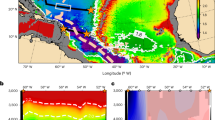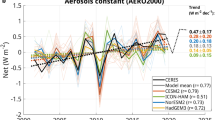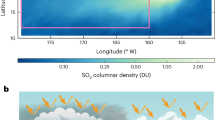Abstract
A shutdown of ocean convection in the subpolar North Atlantic, triggered by enhanced melting over Greenland, is regarded as a potential transition point into a fundamentally different climate regime1,2,3. Noting that a key uncertainty for future convection resides in the relative importance of melting in summer and atmospheric forcing in winter, we investigate the extent to which summer conditions constrain convection with a comprehensive dataset, including hydrographic records that are over a decade in length from the convection regions. We find that warm and fresh summers, characterized by increased sea surface temperatures, freshwater concentrations and melting, are accompanied by reduced heat and buoyancy losses in winter, which entail a longer persistence of the freshwater near the surface and contribute to delaying convection. By shortening the time span for the convective freshwater export, the identified seasonal dynamics introduce a potentially critical threshold that is crossed when substantial amounts of freshwater from one summer are carried over into the next and accumulate. Warm and fresh summers in the Irminger Sea are followed by particularly short convection periods. We estimate that in the winter 2010–2011, after the warmest and freshest Irminger Sea summer on our record, ~40% of the surface freshwater was retained.
This is a preview of subscription content, access via your institution
Access options
Access Nature and 54 other Nature Portfolio journals
Get Nature+, our best-value online-access subscription
$29.99 / 30 days
cancel any time
Subscribe to this journal
Receive 12 print issues and online access
$209.00 per year
only $17.42 per issue
Buy this article
- Purchase on Springer Link
- Instant access to full article PDF
Prices may be subject to local taxes which are calculated during checkout





Similar content being viewed by others
References
Clark, P. U., Pisias, N. G., Stocker, T. F. & Weaver, A. J. The role of the thermohaline circulation in abrupt climate change. Nature 415, 863–869 (2002).
Rahmstorf, S. Ocean circulation and climate during the past 120,000 years. Nature 419, 207–214 (2002).
Lenton, T. M. et al. Tipping elements in the Earth’s climate system. Proc. Natl Acad. Sci. USA 105, 1786–1793 (2008).
Lozier, M. S. Overturning in the North Atlantic. Annu. Rev. Mar. Sci. 4, 291–315 (2012).
Trenberth, K. E. & Caron, J. M. Estimates of meridional atmosphere and ocean heat transports. J. Clim. 14, 3433–3443 (2001).
Bamber, J., den Broeke, M., Ettema, J., Lenaerts, J. & Rignot, E. Recent large increases in freshwater fluxes from Greenland into the North Atlantic. Geophys. Res. Lett. 39, L19501 (2012).
Mernild, S. H. et al. Freshwater flux to Sermilik Fjord, SE Greenland. The Cryosphere 4, 453–465 (2010).
Pickart, R. S., Straneo, F. & Moore, G. W. K. Is Labrador Sea water formed in the Irminger Basin? Deep Sea Res. I Oceanogr. Res. Pap. 50, 23–52 (2003).
Våge, K. et al. The Irminger Gyre: circulation, convection, and interannual variability. Deep Sea Res. I Oceanogr. Res. Pap. 58, 590–614 (2011).
Lavender, K. L., Davis, R. E. & Owens, W. B. Observations of open-ocean deep convection in the Labrador Sea from subsurface floats. J. Phys. Oceanogr. 32, 511–526 (2002).
Pickart, R. S., Torres, D. J. & Clarke, R. A. Hydrography of the Labrador Sea during active convection. J. Phys. Oceanogr. 32, 428–457 (2002).
Hurrell, J. W., Kushnir, Y., Ottersen, G. & Visbeck, M. in The North Atlantic Oscillation: Climatic Significance and Environmental Impact 1–35 (American Geophysical Union, Washington, DC, USA, 2003).
Hanna, E. et al. Atmospheric and oceanic climate forcing of the exceptional Greenland ice sheet surface melt in summer 2012. Int. J. Climatol. 34, 1022–1037 (2014).
Lazier, J., Hendry, R., Clarke, A., Yashayaev, I. & Rhines, P. Convection and restratification in the Labrador Sea, 1990–2000. Deep Sea Res. I Oceanogr. Res. Pap. 49, 1819–1835 (2002).
Gill, A. E. Atmosphere–Ocean Dynamics (International Geophysics Series) (Academic Press, San Diego, CA, USA, 1982).
Ferreira, D. & Frankignoul, C. The transient atmospheric response to midlatitude SST anomalies. J. Clim. 18, 1049–1067 (2005).
Deser, C., Tomas, R. A. & Peng, S. The transient atmospheric circulation response to North Atlantic SST and sea ice anomalies. J. Clim. 20, 4751–4767 (2007).
Czaja, A. & Frankignoul, C. Observed impact of Atlantic SST anomalies on the North Atlantic oscillation. J. Clim. 15, 606–623 (2002).
Gastineau, G., D’Andrea, F. & Frankignoul, C. Atmospheric response to the North Atlantic Ocean variability on seasonal to decadal time scales. Clim. Dyn. 40, 2311–2330 (2013).
Gastineau, G., L’Hévéder, B., Codron, F. & Frankignoul, C. Mechanisms determining the winter atmospheric response to the Atlantic overturning circulation. J. Clim. 29, 3767–3785 (2016).
Cassou, C., Deser, C. & Alexander, M. A. Investigating the impact of reemerging sea surface temperature anomalies on the winter atmospheric circulation over the North Atlantic. J. Clim. 20, 3510–3526 (2007).
Fröb, F. et al. Irminger Sea deep convection injects oxygen and anthropogenic carbon to the ocean interior. Nat. Commun. 7, 13244 (2016).
De Jong, M. F. & de Steur, L. Strong winter cooling over the Irminger Sea in winter 2014–2015, exceptional deep convection, and the emergence of anomalously low SST. Geophys. Res. Lett. 43, 7106–7113 (2016).
Yashayaev, I. & Loder, J. W. Further intensification of deep convection in the Labrador Sea in 2016. Geophys. Res. Lett. 44, 1429–1438 (2017).
Hanna, E., Cropper, T. E., Hall, R. J. & Cappelen, J. Greenland Blocking Index 1851–2015: a regional climate change signal. Int. J. Climatol. 36, 4847–4861 (2016).
Straneo, F. Heat and freshwater transport through the central Labrador Sea. J. Phys. Oceanogr. 36, 606–628 (2006).
Fan, X., Send, U., Testor, P., Karstensen, J. & Lherminier, P. Observations of Irminger Sea anticyclonic eddies. J. Phys. Oceanogr. 43, 805–823 (2013).
IPCC Climate Change 2013: The Physical Science Basis (eds Stocker, T. F. et al.) (Cambridge Univ. Press, 2014).
Gentemann, C. L., Meissner, T. & Wentz, F. J. Accuracy of satellite sea surface temperatures at 7 and 11 GHz. IEEE Trans. Geosci. Remote Sens. 48, 1009–1018 (2010).
Reynolds, R. W. et al. Daily high-resolution-blended analyses for sea surface temperature. J. Clim. 20, 5473–5496 (2007).
Rayner, N. A. et al. Global analyses of sea surface temperature, sea ice, and night marine air temperature since the late nineteenth century. J. Geophys. Res. Atmos. 108, 4407 (2003).
Le Traon, P. Y., Nadal, F. & Ducet, N. An improved mapping method of multisatellite altimeter data. J. Atmos. Ocean. Technol. 15, 522–534 (1998).
Dee, D. P. et al. The ERA-Interim reanalysis: configuration and performance of the data assimilation system. Q. J. R. Meteorol. Soc. 137, 553–597 (2011).
Mote, T. L. et al. Greenland surface melt trends 1973–2007: evidence of a large increase in 2007. Geophys. Res. Lett. 34, L22507 (2007).
Acknowledgements
We thank the staff at the NOAA/OAR/ESRL, NCAR and Hadley Centre for providing the SST data, and the staff at Ssalto/Duacs, Aviso and CNES for producing and distributing the altimeter products. We also appreciate the efforts that went into the development and management of the Ocean Observatories Initiative. The research in this study contributes to the projects ‘Blue-Action’ and ‘AtlantOS’ and was funded by the EU Horizon 2020 Programme under grant agreements 727852 and 633211. It was further supported by the German Federal Ministry of Education and Research as part of the ‘Regional Atlantic Circulation and Global Change’ project.
Author information
Authors and Affiliations
Contributions
J.F. and J.K. were involved in planning, acquiring and processing the mooring data. M.O. and J.K. conceived the story. M.O. carried out the data analysis and interpreted the results. All authors contributed to writing the paper.
Corresponding author
Ethics declarations
Competing interests
The authors declare no competing interests.
Additional information
Publisher’s note: Springer Nature remains neutral with regard to jurisdictional claims in published maps and institutional affiliations.
Supplementary information
Supplementary Information
Supplementary Figures 1–9, Supplementary Table 1 and Supplementary References
Rights and permissions
About this article
Cite this article
Oltmanns, M., Karstensen, J. & Fischer, J. Increased risk of a shutdown of ocean convection posed by warm North Atlantic summers. Nature Clim Change 8, 300–304 (2018). https://doi.org/10.1038/s41558-018-0105-1
Received:
Accepted:
Published:
Issue Date:
DOI: https://doi.org/10.1038/s41558-018-0105-1
This article is cited by
-
Seasonality of the Meridional Overturning Circulation in the subpolar North Atlantic
Communications Earth & Environment (2023)
-
Rapid transfer of oxygen to the deep ocean mediated by bubbles
Nature Geoscience (2020)



